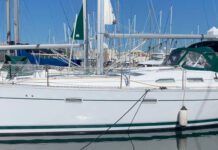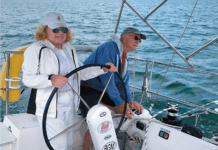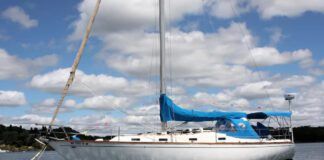
Most sailors prefer quiet to noise. Some things, however—engines and gensets come to mind—are inherently noisy. Which brings us to the subject of sound-proofing.
Sound-proofing can be achieved through in a variety of forms: mats, tapes, and sheets being the most popular (we’ve tested and reported on sound-proofing materials several times, most recently in Oct. 1, 1999). At a recent boat show, we came across a new sound-proofing material, in a different form—a paint. Silent Running 1000 is a gray paint that can be applied to just about any surface by brush, spray, or roller. It’s water-based, and rather thick for a paint, but we found that it went on easily by roller or brush. It was dry to the touch (and ready for a recommended second coat) in less than one hour. It takes up to a week of curing before it fully develops its sound-deadening properties, and it can be top-coated with any ordinary paint if you don’t like gray.
Silent Running absorbs sound through a property called viscoelasticity. Sound, because it’s a form of energy, can’t be destroyed, but it can be converted into another form of energy—in this case, heat. The rise in temperature is so small it’s unnoticeable. The whole process is similar to the conversion of energy you’d get by trying to vigorously stir a jar of molasses.
We subjected Silent Running to a simple, but effective test. We took an 8″-square panel of sheet steel, and applied two coats of the paint. After a week, we hung the panel from a string, hit it with a hammer and listened. Where an unpainted panel produced a loud, ringing “bong” (something like the sound of the gong that was the trademark of J. Arthur Rank movies way back when), the treated panel produced a dull thud. We’d expect a similar degree of sound deadening if we were to apply Silent Running to a genset enclosure or engine room hatch. In fact, we’re planning on including Silent Running 1000 in our next full test of sound-absorbing products.
According to Current Inc., which makes Silent Running 1000, the product is non-toxic, VOC-free, won’t burn, and will withstand temperatures from minus 30° to 375° F. It’s resistant to gas, oil, and most chemicals. And it’s much easier to apply to irregular surfaces than more conventional soundproofers. At the applied thickness of 1/16″, which PS obtained with two coats, it takes up less space than most other methods. At $150 per gallon, it’s not cheap, but it seems a good bet to help make life on board a lot quieter.
Contact – Current, Inc., 877/436-6542, http://silentrunning.us/.









































